#River Trebbia
Text
youtube
Devil’s Bridge The Ponte Gobbo (Hunchback Bridge) also known as Ponte Vecchio (Old Bridge) or Ponte del Diavolo (Devil’s Bridge) is an ancient bridge with an irregular profile, which crosses the River Trebbia in a small town called Bobbio, on the Piacenza’s Apennines.
#droneflight#Bobbio#italy#bridge#devil's bridge#The Ponte Gobbo#(Hunchback Bridge)#Ponte Vecchio#(Old Bridge)#Ponte del Diavolo#River Trebbia#Piacenza’s Apennines#myriam en dirk#Youtube
2 notes
·
View notes
Text
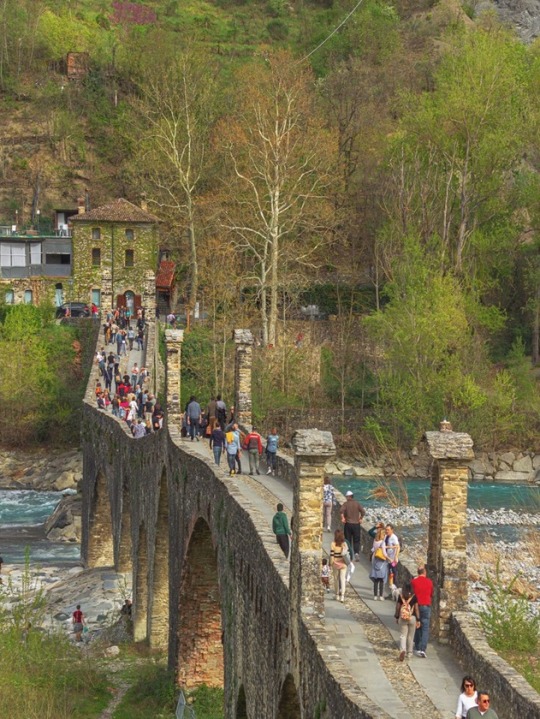
Bobbio is a small town located in the Trebbia River Valley in Italy.
4 notes
·
View notes
Text
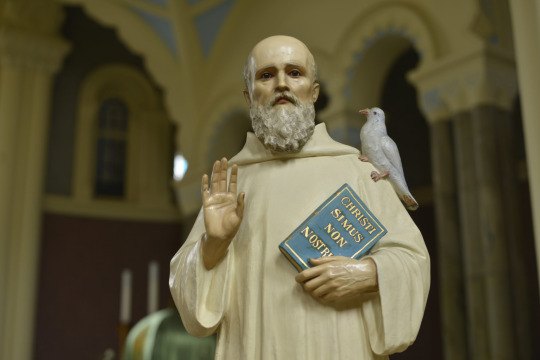
THE DESCRIPTION OF SAINT COLUMBANUS (Columban)
The Patron Saint of Motorcyclists
Feast Day: November 23
"Be friendly with men of honor, stiff with rascals. Be gentle to the weak, firm to the stubborn, steadfast to the proud, humble to the lowly. Be ever sober, ever chaste, ever modest. Be patient as far as is compatible with zeal."
The greatest missionary in all of Ireland, Columbanus or Columban, was born in the year 543 at Leinster, Kingdom of Meath (now part of Ireland). After his conception, his mother was said to have had a vision of her child's 'remarkable genius'.
When he was young, several girls made advances to him; and a holy woman from whom he asked advice, said: 'You think that you can freely avoid women. Do you remember Adam who yielded to Eve? Samson made weak by Delilah? David lured from his former righteousness by the beauty of Bathsheba? The wise Solomon deceived by love of women? Go away, turn from the river into which so many have fallen.'
He was first educated under Abbot Sinell of Cluaninis, whose monastery was on an island of the River Erne, in modern County Fermanagh. Under his instruction, Columbanus composed a commentary on the Psalms. Later, he left his family and entered the monastic life to Bangor Abbey, where he studied to become a teacher of the Bible. Columbanus set sail with twelve companions, and they crossed the channel via Cornwall and landed in Saint-Malo, Brittany. This is where he preached to the people and founded many monasteries of strict discipline. Women and visitors were not allowed to enter, and monks could eat in proportion to the amount of their labor.
As fearless as he was righteous, Columban once stormed onto a scene of debauchery and smashed the cask of alcohol. His objections were not confined to revelers either: He would tell bishops, kings, even popes, where he felt they went wrong. And he made enemies due to his criticism of local clergy whom he viewed as debased.
Columbanus and his companions were welcomed by King Guntram of Burgundy (Guntramnus), who granted them land at Anegray, where they converted a ruined Roman fortress into a school. Despite its remote location in the Vosges Mountains, the school rapidly attracted so many students that they moved to a new site at Luxeuil and then established a second school at Fontaines. These schools remained under Columbanus' authority, and their rules of life reflected the Celtic tradition in which he had been educated.
They had to keep silence most of the time, in order to be recollected with God and to avoid the sins of the tongue. As he said: 'Men like nothing better than discussing and minding the business of others, passing superfluous comments and random and criticizing people behind their back. So those who do not have a discerning tongue should keep silent, of if they do say anything, it should promote peace.'
During the last year of his life, Columbanus received messengers from King Chlothar II, inviting him to return to Burgundy, now that his enemies were dead. Columbanus did not return, but requested that the king should always protect his monks at Luxeuil Abbey. He prepared for death by retiring to his cave on the mountainside overlooking the Trebbia river, where, according to a tradition, he had dedicated an oratory to Our Lady. Columban died at Bobium, Kingdom of the Lombards on November 21, 615.
The Rule of Saint Columbanus embodied the customs of Bangor Abbey and other Irish monasteries. Much shorter than the Rule of Saint Benedict, the Rule of Saint Columbanus consists of ten chapters, on the subjects of obedience, silence, food, poverty, humility, chastity, choir offices, discretion, mortification, and perfection.
There are ten miracles attributed to Columban's intercession: from procuring food from a sick monk and curing the benefactor's wife, destroying with his breath a cauldron of beer prepared for a pagan festival, to taming a bear and yoking it to a plough.
The Missionary Society of Saint Columban, founded in 1916, and the Missionary Sisters of St. Columban, founded in 1924, are both dedicated to Columbanus.
0 notes
Text
The North
As many of you might know, I completed my year abroad in the Deep South of Italy– more specifically the city of Lecce in the beachy Puglia region. There are many stereotypes about Southern Italians– not just from snooty northerners but from global onlookers. This is conversation for another blog post, however. For now I’ll review a couple of my visits to cities in the north of Italy and brief the contrasts between the north and south.
In general:
Architecture is much darker. Southern antique architecture is usually in light colored stone or white, leaning towards more baroque and romanesque styles, always with relatively short structure and large facades for an interior that was usually less grand. whereas most of the architecture I saw in the north was dark, often gothic or bricky, and reached up very tall.
The weather is much colder/ rainy as to be expected.
People are less hospitable.
The cities have odd sewer smells.:(
In order of increasing size….
Bobbio
A village in the mountains of Emilia-Romagna. A population of about 3K. Despite the size, very historic. It rests next to the river Trebbia and hides an ancient and beautiful church/ monestary. Had some lovely farm bread and salumi with a Bobbio cake here.
Crema
The small town in which a little movie by the name of Call Me By Your Name was filmed! This was a treat to see. With the help of a friends short term host mom we managed to finagle our way into the gardens of the CMBYN house itself. The center of the city was surprisingly quaint and filled with a duo of beautiful churches and kind people who were very proud of their city’s reputation.
Piacenza
The city I stayed in for my ‘Settimana di Scambio’ (exchange week). A city of about 100K. While the dark brick architecture is lovely (another great church!) and it had the culture of a small city trying to rise (bi-weekly antique markets, bio-friendly food fairs, public parks, etc.), the city was not much to discuss. It was more spread out and less accessible by foot, and had an odd smell throughout the whole city.
Bologna
One of THE MOST underrated cities for international visitors, however this is becoming less and less true every day. Bologna is built around one of the oldest and largest universities in continental Europe. The city is antique and concentrated but houses a spirit of youth and life coming from its student presence. The large, dark architecture heavily spotted with greenery and art make it a lovely place to visit, and I could see myself living there.
Milan
Much to metropolitan for me. As an Italian city it lacks a real metro core, and seems like a small Italian town with one beautiful church dressing up in a suit and tie for business work. Everyones constantly in a rush to be somewhere and the city itself is dirty. Some small areas were quite nice and seemed livable but overall Ive seen many cities with more charming hearts.
Florence
Perhaps my favorite looking city I visited. I was quite disappointed that I didn’t get to go back there after my family trip was cancelled. Il Duomo di Firenze is likely the most breathtaking work of architecture I have ever seen, and I would have loved to have time to see the inside or climb the clock tower. Firenze is also home to a vast array of legendary artwork and continues to expand its collection. Very very touristy and crowded.

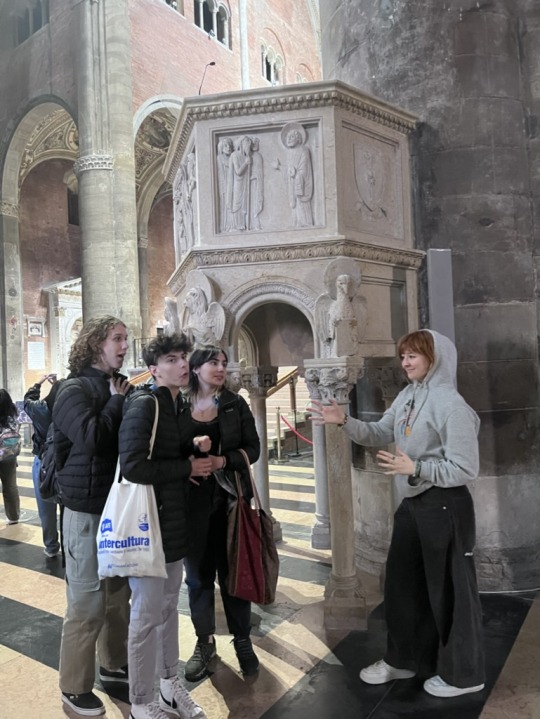
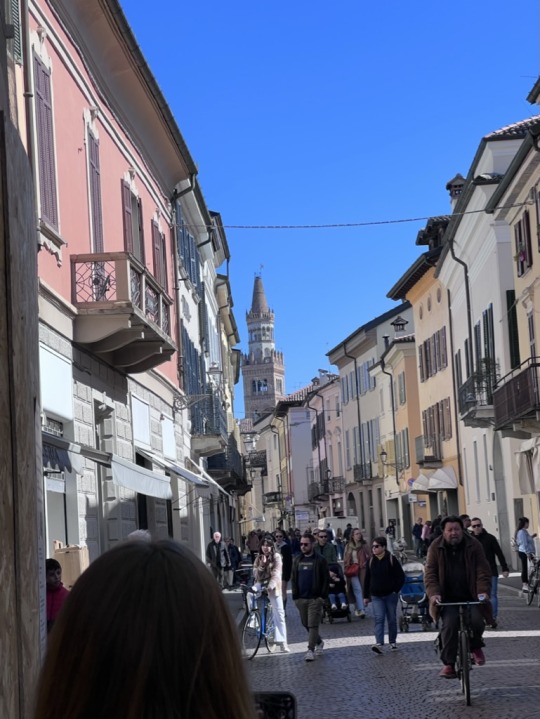

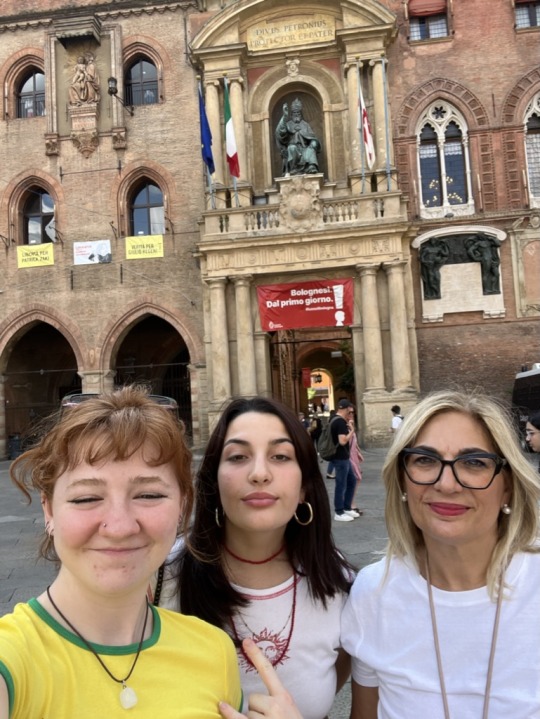
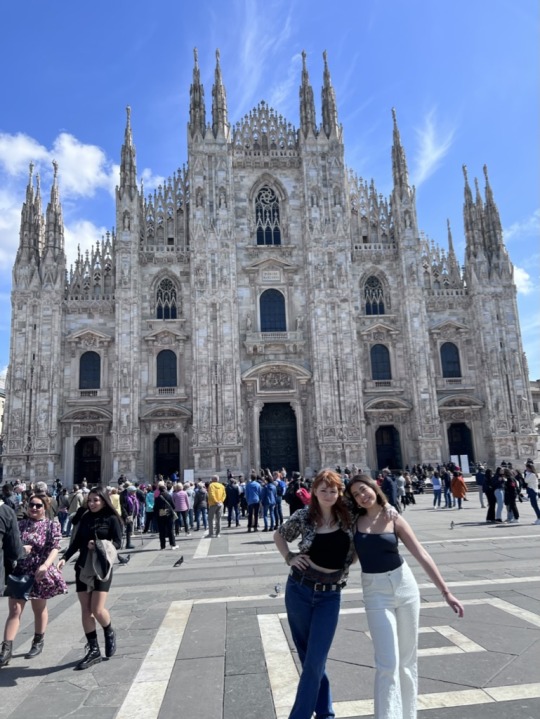

0 notes
Text
Piacenza, dives into the Trebbia to save his son: both drown
He dived into the Trebbia river to save his 28-year-old son in distress, at a point where the water is three meters deep, but he too disappeared, carried away by the current and found a little further downstream by firefighters. It happened at 16 in the province of Piacenza. The 59-year-old man originally from Sri Lanka drowned with his son in front of the eyes of the other swimmers who called…

View On WordPress
0 notes
Photo

Ponte Gobbo
Luciano Lucci©
3 notes
·
View notes
Photo

C'era una volta il Ponte Lenzino tra Corte Brugnatella e Cerignale, a Rovaiola. Solo un paio di mesi fa era ancora lì, come un portale, un palcoscenico naturale di rara bellezza. Ma ora è crollato, le piogge di questi giorni hanno sbriciolato la campata centrale sul greto del Trebbia. Il Lenzino era uno di quei luoghi ai quali senti immediatamente di appartenere, già dalla prima volta che li vivi, come è successo a me. Uno di quei tanti posti segreti lungo le anse del Trebbia che si tramandano a passaparola e perchè un amico tiene a condividere quel luogo con te. L'augurio è che presto si possa ristabilire un passaggio tra le rive, e che il nuovo ponte che verrà rispetti la storia di quello che lo ha preceduto. #pontelenzino #rovaiola #cortebrugnatella #cerignale #bobbio #trebbia #piacenza #bw #landscape #ponte #lumix #river #valtrebbia #crollodelpontelenzino #bridge #emiliaromagna #wildnature #mountains #appennino #italy (presso Ponte Lenzino-Cerignale) https://www.instagram.com/p/CF9fbTiH1Et/?igshid=1c4147q3ei4qp
#pontelenzino#rovaiola#cortebrugnatella#cerignale#bobbio#trebbia#piacenza#bw#landscape#ponte#lumix#river#valtrebbia#crollodelpontelenzino#bridge#emiliaromagna#wildnature#mountains#appennino#italy
0 notes
Text
“Left to himself, he was always a day late”

17 November 1765--Étienne Jacques Alexandre Macdonald, future Marshal of France, is born.
For generations his true character has been obscured by the sympathy English writers felt for him because of his ancestry.
Macdonald was a son of the Wild Geese, his father being a Scots Jacobite refugee who had followed Bonnie Prince Charlie in “the ‘45,” and later obtained a French commission. Macdonald seems to have received some training in a private military school; his first service was with a semi-mercenary legion in the Dutch Army. He later gained a French commission through service as a gentleman cadet. A lieutenant in 1792, he was a colonel a year later, general of brigade in 1794, general of division in 1796. Very brave, energetic, tall and strongly built, with a commanding voice and a natural air of authority, he could make himself obeyed, even by revolutionary levies. Also, he was an expert scrambler, able to dodge the officer-hunting Jacobin extremists who considered “Mac” a title of nobility and to put his own interests above loyalty to commanders who might be in political disfavor. In early 1799 he got command of the Army of Naples through murky intrigue, but it did him little good: Called north to meet an Austro-Russian army under the famous Suvorov, he was badly wounded in a minor skirmish and then defeated at the Trebbia River. Sore in mind and body, he supported Napoleon’s coup d’état.... In 1809, on Clarke’s suggestion, Napoleon ordered Macdonald to northern Italy to serve under Eugène, noting that he could be used as a “wing” (corps) commander if Eugène so desired.... He did serve usefully and capped this at Wagram by leading the assault that cracked the Austrian left center. In 1812 he commanded the X Corps (Poles, Prussians, and various Germans) on Napoleon’s extreme left flank during the invasion of Russia. Though faced by nothing more than small Russian forces and long distances, he moved timidly; worse, he gave no help to Oudinot and St. Cyr on his right flank. (Later he would have the gall to label St. Cyr a “bad bedfellow.”) Doubtless his Prussian officers noted his behavior; once they were enemies again in 1813-14, they exploited his hesitations and flinching. Under the Emperor’s direct command he could still hit hard; left to himself, he was always a day late--when he did not retreat unnecessarily. At Fontainebleau he was prominent in the marshals’ mutiny, though he did his best to secure the French throne for Napoleon’s son. Thereafter he followed Louis XVIII.
Napoleon considered Macdonald brave but unlucky--meaning, in Napoleon’s vocabulary, that he lacked the quickness of mind to meet unexpected developments. He could be audacious, but too often unthinkingly so: At the Trebbia and again at the Katzbach in 1813 he deliberately crossed a difficult stream on a broad front against a superior enemy, at the Katzbach despite Napoleon’s express orders.
Macdonald suffered from a tendency to free and sarcastic speech, never missing a chance for a jest--preferably barbed. On reexamination, his Souvenirs are unreliable history; he blandly claims credit for actions where he was not present and blames his failures on his subordinates.
By making him a marshal, Napoleon hung a millstone around his own neck. With Oudinot and Marmont, that made three millstones.
--John R. Elting, Swords Around a Throne: Napoleon’s Grande Armée
#Étienne Jacques Macdonald#Nicolas Charles Oudinot#Napoleon's marshals#today in history#Napoleonic wars#Laurent de Gouvion Saint-Cyr
35 notes
·
View notes
Photo

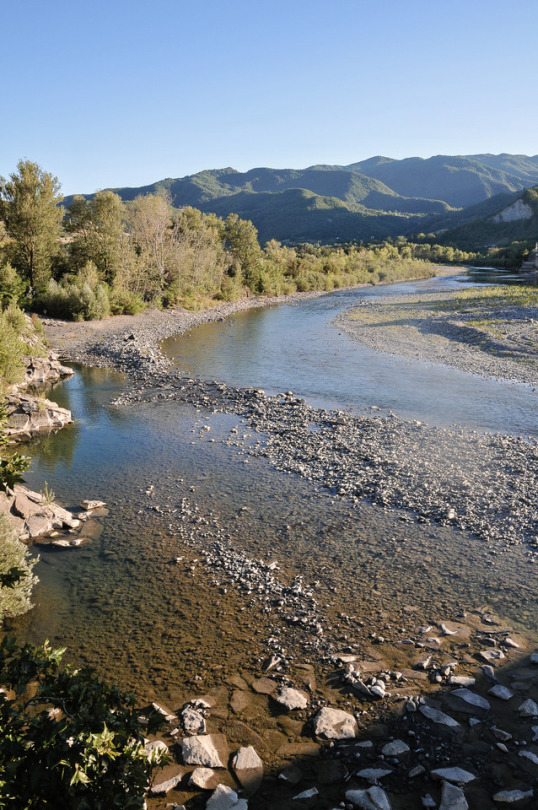
#Trebbia#valtrebbia#bobbio#Italy#river#bridge#landscape#stephenshore#edwardburtynsky#alecsoth#opticxllyaroused#lensculture#beach#nodrone
2 notes
·
View notes
Text
November 23 is the feast day of Pope Clement I, martyr and Saint Columbanus
Pope Clement I

Pope Clement I (Latin: Clemens Romanus; Greek: Κλήμης Ῥώμης; died 99), also known as Saint Clement of Rome, holding office from 88 to his death in 99.
According to apocryphal acta dating to the 4th century at earliest, Clement was banished from Rome and was set to work in a stone quarry. Finding on his arrival that the prisoners were suffering from lack of water, he knelt down in prayer. Looking up, he saw a lamb on a hill, went to where the lamb had stood and struck the ground with his pickaxe, releasing a gushing stream of clear water. This miracle resulted in the conversion of large numbers of the local pagans and his fellow prisoners to Christianity. As punishment, Clement was martyred by being tied to an anchor and thrown from a boat into the Black Sea.
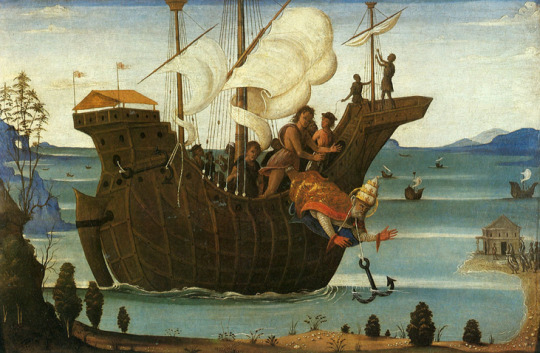
Clement is recognized as a saint in many Christian churches and is considered a patron saint of mariners. He is commemorated on 23 November in the Catholic Church, the Anglican Communion, and the Lutheran Church In Eastern Orthodox Christianity his feast is kept on 24 or 25 November.
A year or two before his own death in 869, Cyril brought to Rome what he believed to be the relics of Saint Clement, bones he found in the Crimea buried with an anchor on dry land. They are now enshrined in the Basilica di San Clemente.Other relics of Saint Clement, including his head, are claimed by the Kyiv Monastery of the Caves in Ukraine.
Saint Columbanus

Prior to his birth, his mother was said to have had visions of bearing a child who, in the judgment of those interpreting the visions, would become a "remarkable genius".Columbanus was well-educated in the areas of grammar, rhetoric, geometry, and the Holy Scriptures.
He founded monasteries in an abandoned Roman fortress and castles. His monasteries were known for the strictness of their rules (which the Benedictines later ameliorated) and their emphasis on corporal punishment. In addition to his rule for monks, Columbanus wrote a peneteniary and poems.
As these communities expanded and drew more pilgrims, Columbanus sought greater solitude, spending periods of time in a hermitage and communicating with the monks through an intermediary. Often he would withdraw to a cave seven miles away, with a single companion who acted as messenger between himself and his companions.
He prepared for death by retiring to his cave on the mountainside overlooking the Trebbia river, where, according to a tradition, he had dedicated an oratory to Our Lady. Columbanus died at Bobbio on 21 November 615.
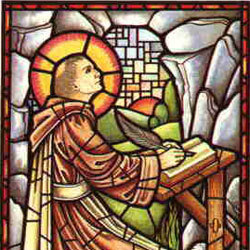
source: https://en.wikipedia.org, https://www.catholic.org/
7 notes
·
View notes
Photo

Boelli state of mind. . . . #trebbia #boelli #casa #valtrebbia #dietrocasa #fallountuffo #acquafresca #river #beiposti #beautifulplace #peace #nature
#acquafresca#casa#trebbia#dietrocasa#fallountuffo#peace#river#nature#beautifulplace#valtrebbia#boelli#beiposti
1 note
·
View note
Text
ADHD
Artistic activities are a great help for an ADHD child. So, last Friday, with digital camera, he stood in the middle of the river (low level and with clear water - the Trebbia, an Italian jewel -), patiently, bent, with his camera underwater, he waited for the little fishes passed. He had satisfaction. He made a very small video (which unfortunately does not load on the blog) and a little fish even approached, intrigued. A splendid day.
1 note
·
View note
Text
Interesting! Thank you😁❤️❤️❤️❤️
Mysteries surrounding Leonardo Da Vinci’s ‘Mona Lisa’
People often say, “A picture paints/says a thousand words.” While that holds true for most pictures, Leonardo da Vinci’s Mona Lisa has for centuries continued to evade the understanding of art critics, historians, and the public. On display in the Louvre, the tiny portrait is often touted as “the best known, the most visited, the most written about, the most sung about, the most parodied work of art in the world.
Who is she?
The true identity of the portrait sitter remains a mysterious aspect. The majority of thinkers believe the woman to be 24-year-old Lisa Maria de Gherardini (aka Lisa del Giocondo), an Italian noblewoman born in Florence in 1479.
Her portrait was commissioned by her husband, Francesco di Bartolomeo di Zanobi del Giocondo. She lived a middle-class life with her husband working as a silk and cloth merchant. She conceived five children: Piero, Andrea, Camilla, Giocondo, and Marietta.
Other hypotheses suggest that the woman in the painting matches the face of Caterina Sforza, the countess of Forli, and a most formidable foe in military operations. Another theory proposes the young lady to be a mistress of Giuliano de’ Medici, the ruler of Florence, or Isabella d’Este, the marquise of Mantua. Others have thought the woman to be a portrait of da Vinci’s mother or da Vinci himself due to the similarity of facial structures.
The Mona Lisa smile
Mona Lisa’s enigmatic, intriguing, and profoundly perplexing smile is perhaps one of the most mysterious elements of da Vinci’s oil painting.
For five centuries, it has been argued whether she is smiling at all, whether she’s happy, or whether she’s sad. Professor Margaret Livingstone of Harvard University suggests that the “low spatial frequencies” at which the portrait is painted creates a striking smile when viewers look into her eyes. With the development of “emotion recognition” computer programs in 2005 by Dutch researchers, the painting was revealed to be 83 percent happy, 9 percent disgusted, 6 percent fearful, 2 percent angry, less than 1 percent neutral, and 0 percent surprised. However, many have said that her smile changes depending on where you look and at which angle and distance. In a close-up viewing, the fine detail gives the impression of a demure expression. But from far away, she appears to be smiling cheerfully.
Secret codes
Through the microscope’s magnification of high-resolution images of the painting, Italy’s National Committee for Cultural Heritage has revealed the presence of a series of letters and numbers painted on numerous features of the canvas.
In Mona Lisa’s right eye, art historian Silvano Vinceti states that the letters “LV” appear, which is theorized to represent the artist’s own name, Leonardo da Vinci. In the left eye, the unclear outlines of the letters “CE” or possibly a “B” can be viewed. The bridge in the background features the number “72” or the letter “L” followed by a “2” painted onto its arch. One may wonder what the artist intended when he mysteriously painted these letters and numbers in a form invisible to the naked eye.
The unknown bridge
The dreamlike vista behind Mona Lisa’s head is often overshadowed by the allure of her face. But the three-arched bridge in the background begs the question about the exact location of the hazy, mysterious landscape.
Italian historian Carla Glori suggests that the bridge featured over the left shoulder of the woman is known as the Ponte Gobbo or Ponte Vecchio (“Old Bridge”). It is situated in Bobbio, a small village in a hilly country south of Piacenza in northern Italy. Glori’s theory follows Vinceti’s finding of the number “72” secretly hidden in the stone bridge. She proposes that the number is a reference to the year 1472. In 1472, a disastrous flood occurred. The River Trebbia burst its banks and destroyed the bridge of Bobbio. In her book The Leonardo Enigma, Glori theorizes that “Leonardo added in the number 72 beneath the bridge to record the devastating flood of the River Trebbia and to allow it to be identified.”
An unsettling gaze
How is it possible that her gaze seems to extend beyond the confines of the painting, but simultaneously, it is directly held at the viewer? No matter where you move, she continues to meet you eye to eye. In our three-dimensional world, shadows and light on surfaces should shift according to our vantage point. But this does not correlate to a two-dimensional surface.
This optical phenomenon can be explained by a scientific understanding described by the University of Ohio which shows that an image may appear exactly the same no matter the angle at which it is viewed. Unknown to Leonardo da Vinci, his masterful manipulation of chiaroscuro on the canvas creates an intensely realistic sense of depth in the interplay of shadow and light. Indeed, this phenomenon creates perspective and gives the Mona Lisa her unsettling gaze.
A hidden painting behind the portrait
Using infrared and laser imaging on the Mona Lisa in 2006, scientists in Canada revealed da Vinci’s rudimentary sketches, including a change of position in the index and middle fingers of the left hand. Through this, numerous discoveries emerged, such as the lace drawn on Mona Lisa’s dress and the blanket on her knees extending to cover her stomach.
In 2015, French engineer Pascal Cotte used similar techniques of projecting light beams at varying wavelengths onto the work and measuring the quantities of light reflected back. Curiously, his discovery presented a secret portrait behind the Mona Lisa we see today. In what Cotte terms the “layer amplification method,” he states, “We can analyze exactly what happens inside the layers of the painting’s creation, and we can peel them like an onion.” Cotte found four images beneath the uppermost painted surface, including a painting of a younger woman with petite facial features and no smile.
Different theories have surfaced surrounding the real identity of the woman in the painting, but perhaps her true face will always remain a mystery.
The pregnant Mona Lisa
The art historians who think that the woman is Lisa del Giocondo also believe that she was with child when da Vinci painted her. Her arms crossed over her rounded stomach as well as historical evidence that suggests del Giocondo was pregnant for the second time when the painting was done perpetuate the idea that Mona Lisa was expecting. Furthermore, the infrared scans indicate evidence of a guarnello (“veil”) draped across her shoulders. A guarnello is an overgarment made of linen and worn by a pregnant woman.
It has been speculated that this veil could simply be a scarf or piece of fabric hung over her shoulders. However, the Mona Lisa’s hands over her stomach, the historically accurate timing of her pregnancy with that of del Giocondo’s, and the similar use of a guarnello on the pregnant Smeralda Brandini in Sandro Botticelli’s portrait suggest that Mona Lisa was mysteriously hiding a baby bump.
Why we find her beautiful
Throughout history, the portrait of Mona Lisa has been cited as an example of timeless beauty. It would be very limiting to suggest that the Mona Lisa’s beauty and intrigue is restricted only to her gaze and her smile as it seems to extend beyond these two features into a transcendental and ineffable beauty that is felt.
The golden ratio is derived from the length to width dimensional relationship of rectangles and is supposedly the most aesthetically pleasing proportion to the human eye. Present in natural structures such as the spiraled center of sunflowers and the man-made columns of the Parthenon, the golden ratio was termed the “divine proportion” by Leonardo da Vinci himself.
When a rectangle is formed around Mona Lisa’s face as per the ratio, her chin, the top of her head, and her nose are exactly aligned. The prevalence of this golden ratio in the artwork perhaps explains the mysterious intrigue felt by those who behold the portrait. Her proportions are deemed the most pleasing to the eye, producing a sense of natural balance and beauty. Who knew that mathematics could explain this long-held sense of allure?
Stolen painting
The Mona Lisa was stolen in 1911 by an Italian employee at the Louvre named Vincenzo Perugia. (Some spell his last name “Peruggia.”) He believed that the painting had been stolen from Florence by Napoleon Bonaparte and wished to see it returned to its “true home.”
For two years, the location of the painting remained a complete mystery as media coverage worldwide speculated on possible reasons for its absence and its location. Then, in 1913, Perugia came into contact with Italian art dealer Alfredo Geri. Perugia requested a monetary reimbursement from the Italian government in exchange for transporting the Mona Lisa back to Florence. Upon the painting’s return, speculation continued. Perugia’s offer to return the painting to Italy had seen him request a rather modest amount of money. The public began questioning whether the incident of the stolen painting was all a ruse created to increase interest in the painting and the gallery.
Vacant wall in the Salon Carré, Louvre after the painting was stolen in 1911
When it was revealed that the thief behind the stolen painting—who had collaborated with Perugia—was none other than the well-known art forger Eduardo de Valfierno, people began theorizing that the Mona Lisa was stolen to make a copy of the painting and sell the forged copies to unaware art collectors for vast amounts of money.
The ill Mona Lisa
The mystery behind Mona Lisa’s lopsided smirk has perhaps finally been cracked by a Boston physician standing in line and waiting to view the tiny painting. Dr. Mandeep R. Mehra diagnosed Mona Lisa with a glandular condition as he noticed the odd details of her appearance—her sallow complexion, thinning hair, and misaligned smile. Mehra works as the medical director of the Heart and Vascular Center at the Brigham and Women’s Hospital. He stated his difficulty of appreciating art in competition with his keen eye for clinical diagnoses.
Mehra observed the presence of a small, fleshy bump in the inner corner of her left eye, her thin and receding hairline, her lack of eyebrow hair, and a bulge next to her index finger. Coupled with her yellow skin and the bump on her neck as an indicator of an enlarged thyroid gland, he suggested that her odd smile may be caused by muscle weakness. Thus, he came to the conclusion that Mona Lisa was suffering from a condition called hypothyroidism, in which her swollen hands, thin and lank hair, and lump on her neck all feature prominently in da Vinci’s portrait. Mehra furthered his investigation into the historical conditions surrounding the woman’s diet and discovered that iodine-deficient food was commonly eaten in the early 16th century. As iodine is an essential nutrient with the role of maintaining thyroid health, the mystery of Mona Lisa’s curious smile might finally be put to rest.
12 notes
·
View notes
Photo
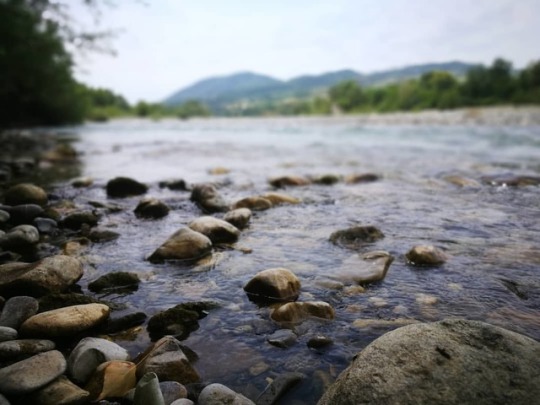
down by the trebbia river. #travo #rivergaro #trebbia #trebbiariver #fiume #fiumetrebbia #valleditrebbia #trebbiaexperience #emiliaromagna #instatrebbia #igerstrebbia #trebbiavalley #ig_trebbia #piacenza #piacenzacity (presso Travo Pietra Parcellara) https://www.instagram.com/p/ByfqjuzoKHWLf7ng2ThhS97iH-1Bo6KDSTyaBg0/?igshid=mg621wssbbmw
#travo#rivergaro#trebbia#trebbiariver#fiume#fiumetrebbia#valleditrebbia#trebbiaexperience#emiliaromagna#instatrebbia#igerstrebbia#trebbiavalley#ig_trebbia#piacenza#piacenzacity
1 note
·
View note
Text
Castello Di Rivalta

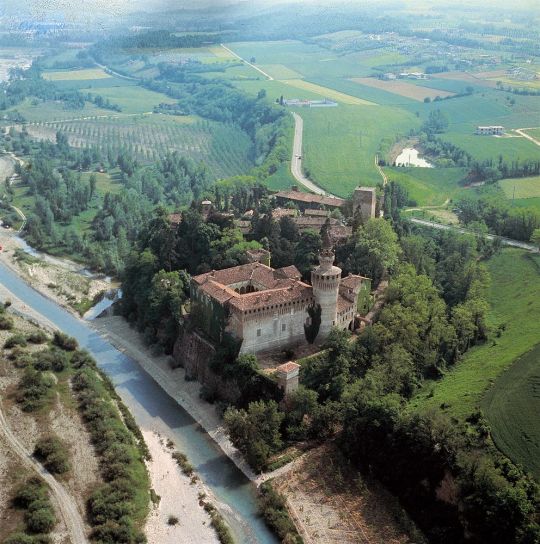
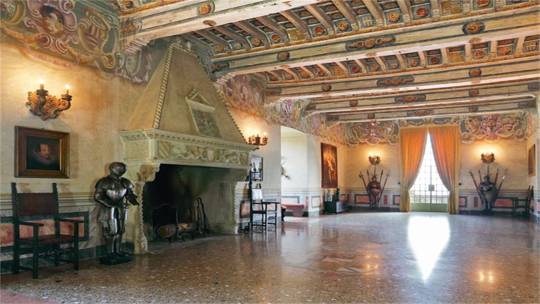

Castello Di Rivalta is located in Rivalta in the Province of Piacenza, Italy. The Village of Rivalta is a fortified complex. The fortified castle overlooks the banks of the river Trebbia. The castle is first mentioned in a purchase in 1025 A.D. In 1048, Emperor Henry II donated the castle to the monastery of San Savino di Piacenza. Throughout the centuries the castle was at the center of many battles, sieges, and treason. The castle switched hands numerous times throughout its history, but in the 14thcentury the land was ceded to the Obizzo Landi family. The Landi family reconstructed the castle into the residence it is today. The decedents of the 14thcentury feudal family still live in the castle. The castle is designed in a quadrangular that houses more than 50 rooms. The internal arcaded courtyard is decorated with marble columns, there’s also a cylindrical tower, a dungeon, a music room, a gallery, a billiards room, and a weapons room. In the 18thcentury more trees were planted to surround the castle’s English style gardens, the façade and some of the rooms were renovated at this time. The Castle serves as a Museum of Military Costume and has a Spa and Wellness center. Castello Di Rivalta is open to the public from February to November.
2 notes
·
View notes
Photo
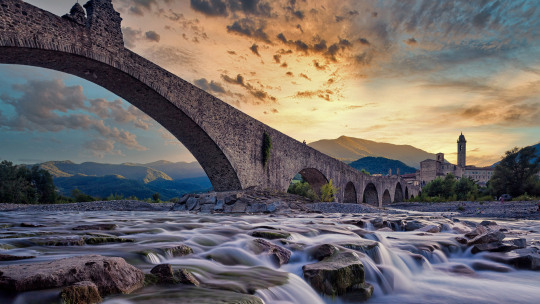
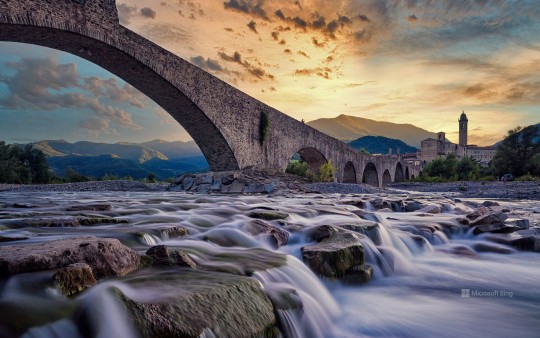
Ponte Vecchio bridge near Bobbio, Italy
© afinocchiaro/Getty Images
*
Today on Bing
March 10, 2022
Ponte Vecchio bridge, Bobbio, Italy
Between Milan – the fashion and design capital of Italy – and the famous seaport city of Genoa, you’ll find this small river town in northern Italy. People have lived here since ancient times, including the Romans, but the town really began to thrive when the abbey was constructed in the 7th century. For much of the Middle Ages, the Bobbio Abbey and its vast library made the town a centre of religion, culture and learning.
These days, Bobbio is a regular tourist stop perhaps best known for its old bridge, or Ponte Vecchio (not to be confused with THE Ponte Vecchio in Florence). Bobbio’s old bridge spans the river Trebbia with 11 arches of unequal size and is commonly called Ponte Gobbo (Hunchback Bridge), because of its irregular shape.
With its many small churches, modest houses and cobblestone streets, Bobbio maintains the character of a medieval village nestled in the Trebbia valley. American novelist Ernest Hemingway described the valley as ‘the most beautiful in the world’, and with views like this, we’re not going to argue with him.
*
Today on Bing
March 10, 2022
On the left bank of the river Trebbia, lies...
Between the metropolis of Milan—the fashion and design capital of Italy—and the fabled seaport city of Genoa, you'll find this small river town in northern Italy. People have resided here since ancient times, including the Romans, but the town really began to flourish when the abbey was constructed in the 7th century. For much of the Middle Ages, the Bobbio Abbey and its vast library made the town a center of religion, culture, and learning.
These days, Bobbio is a regular tourist stop perhaps best known for its old bridge, or Ponte Vecchio (not to be confused with THE Ponte Vecchio in Florence). Bobbio's old bridge spans the river Trebbia with 11 arches of unequal size and is commonly called Ponte Gobbo (Hunchback Bridge), because of its irregular shape.
Bobbio remains a jewel box of a town frozen in time. With its many small churches, modest houses, and cobblestone streets, Bobbio maintains the character of a medieval village nestled the Trebbia valley. Ernest Hemingway described the Val Trebbia as 'the most beautiful in the world,' and with views like this, who could argue with him?
*
Featured on Bing
March 10, 2022
Bobbio, Italy
Between the metropolis of Milan—the fashion and design capital of Italy—and the renowned seaport city of Genoa, you’ll find this small river town in northern Italy. People have resided here since ancient times, including the Romans, but the town really began to flourish when the abbey was constructed in the 7th century. For much of the Middle Ages, the Bobbio Abbey and its vast library made the town a centre of religion, culture, and learning.
These days, Bobbio is a regular tourist stop perhaps best known for its old bridge, or Ponte Vecchio (not to be confused with THE Ponte Vecchio in Florence). Bobbio’s old bridge spans the river Trebbio with 11 arches of unequal size and is commonly called Ponte Gobbo (Hunchback Bridge), because of its irregular shape.
Bobbio remains a jewel box of a town frozen in time. With its many small churches, modest houses, and cobblestone streets, Bobbio maintains the character of a medieval village nestled in the Trebbia valley. Ernest Hemingway described the Val Trebbia as ‘the most beautiful in the world,’ and with views like this, who could argue with him?
*
Featured on Bing
March 10, 2022
The Ponte Vecchio, a bridge near Bobbio, Italy
Between the metropolis of Milan—the fashion and design capital of Italy—and the fabled seaport city of Genoa, you'll find this small river town in northern Italy. People have resided here since ancient times, at least as far back as the Roman era, but the town really began to flourish when the abbey was constructed in the 7th century. For much of the Middle Ages, the Bobbio Abbey and its vast library made the town a center of religion, culture, and learning.
These days, Bobbio is a regular tourist stop perhaps best known for its old bridge, or Ponte Vecchio (not to be confused with THE Ponte Vecchio in Florence). Bobbio's old bridge spans the River Trebbia with 11 arches of unequal size and is commonly called Ponte Gobbo (Hunchback Bridge), because of its irregular shape.
Bobbio remains a jewel box of a town frozen in time. With its many small churches, modest houses, and cobblestone streets, Bobbio maintains the character of a medieval village nestled in the Trebbia Valley. Ernest Hemingway described the Val Trebbia as 'the most beautiful in the world,' and with views like this, who could argue with him?
*
Featured on Bing
10 March 2022
The other Ponte Vecchio
Between the metropolis of Italy’s fashion capital Milan and the coastal city of Genoa, you’ll find this small river town in northern Italy. People have lived here for thousands of years, but the town really began to flourish when the abbey was constructed in the 7th century. For much of the Middle Ages, the Bobbio Abbey and its vast library made the town a centre of religion, culture and learning.
These days, Bobbio is a regular tourist spot perhaps best known for its old bridge, or Ponte Vecchio (not to be confused with THE Ponte Vecchio in Florence). Bobbio’s old bridge spans the river Trebbio with 11 arches of unequal size and is often called Ponte Gobbo (Hunchback Bridge), because of its irregular shape.
With its many small churches, modest houses and cobblestone streets, Bobbio still has the character of a medieval village, nestled in the Trebbia valley.
0 notes